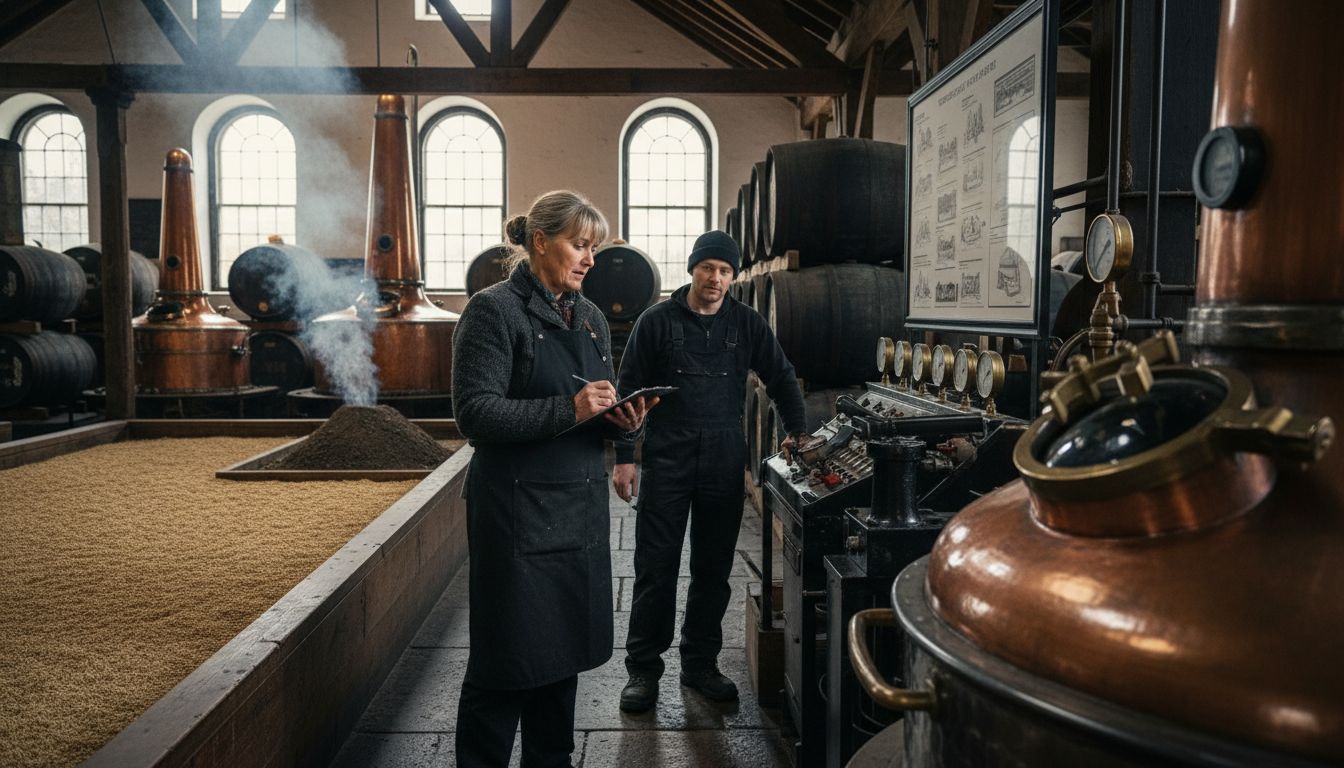Few drinks command the respect and fascination earned by Scotch whisky, a spirit forged through centuries of tradition and strict legal standards. Researchers have identified thousands of unique chemical compounds in every bottle, making the flavor profile unlike anything else in the world. From its deep roots in Scottish culture to its status as a top collectible, discovering what sets Scotch whisky apart reveals not just a drink, but a complex story of craftsmanship and regional identity.
Table of Contents
- What Distinguishes Scotch Whisky Uniquely
- Traditional Production Methods And Origins
- Maturation, Aging, And Regional Differences
- Flavor Profiles And Sensory Appeal
- Investment, Rarity, And Collectible Value
Key Takeaways
| Point | Details |
|---|---|
| Unique Characteristics | Scotch whisky is defined by legal standards, including production in Scotland, use of malted barley, and a minimum aging period of three years. |
| Regional Variations | Different regions in Scotland, such as Islay and Speyside, impart unique flavors, contributing to a diverse whisky landscape. |
| Complex Production Process | The production process from malting to maturation embodies centuries of craftsmanship, transforming basic ingredients into a celebrated spirit. |
| Investment Potential | Certain Scotch whiskies have become valuable collectors’ items, influenced by factors such as age, rarity, and distillery reputation. |
What Distinguishes Scotch Whisky Uniquely
Scotch whisky represents a singular spirit category defined by rigorous legal standards and extraordinary production complexity. According to research from the University of Edinburgh, high-resolution mass spectrometry reveals Scotch whisky comprises thousands of unique chemical compounds, creating an unparalleled flavor landscape that sets it apart from other global spirits.
The legal framework surrounding Scotch whisky establishes its distinctiveness through incredibly precise regulations. As defined by Scottish law, authentic Scotch must be:
- Produced exclusively in Scotland
- Made from malted barley
- Aged in oak barrels for a minimum of three years
- Distilled to no more than 94.8% alcohol by volume
Regional variations further contribute to Scotch’s remarkable diversity. Art of the Cocktail highlights how different Scottish regions impart unique characteristics. Islay whiskies, for instance, are renowned for their distinctive peated profiles, while Highlands malts offer more rounded, complex flavor expressions.
The intricate production process transforms Scotch whisky from a mere alcoholic beverage into a nuanced cultural artifact. Each step - from grain selection to barrel aging - represents generations of accumulated expertise, ensuring that every bottle tells a profound story of Scottish craftsmanship and tradition. Learn more about whisky heritage in our comprehensive guide on global whisky traditions.
Traditional Production Methods and Origins
The art of Scotch whisky production is a testament to centuries of refined craftsmanship, deeply rooted in Scottish cultural heritage. Digital Computational Science reveals that traditional methods involve a meticulous process beginning with malting barley, where grains are carefully germinated and then dried, often using peat that imparts distinctive smoky characteristics.
Historically, Scotch whisky’s origins can be traced back to the 15th century, with early production centered around local monasteries and small-scale distilleries. According to Wikipedia, initial production methods were relatively primitive, utilizing simple pot stills and leveraging ingredients readily available in the Scottish landscape.
The traditional production process encompasses several crucial stages:
- Malting: Barley is soaked in water, allowed to germinate, then dried
- Mashing: Malted barley is ground and mixed with hot water to extract sugars
- Fermentation: Yeast is added to convert sugars into alcohol
- Distillation: The liquid is heated in copper pot stills, concentrating the alcohol
- Maturation: The spirit is aged in oak casks for a minimum of three years
Each stage represents generations of accumulated knowledge, transforming a simple grain into a complex, globally celebrated spirit. Explore more about whisky heritage in our comprehensive guide on global whisky traditions.

Maturation, Aging, and Regional Differences
The maturation process is where Scotch whisky truly transforms from a raw spirit into a complex, nuanced drink. Art of the Cocktail emphasizes that legal requirements mandate a minimum aging period of three years in oak barrels, though many distilleries age their whiskies far longer to develop extraordinary depth and character.
Scotland’s unique geographical regions play a pivotal role in creating distinctive whisky profiles. Wikipedia highlights how the cool Scottish climate contributes to a gradual, nuanced interaction between the whisky and oak casks, resulting in exceptional smoothness and complexity.
Key regional variations include:
- Islay: Known for intensely peated whiskies with robust, smoky characteristics
- Speyside: Renowned for sweet, fruity profiles often enhanced by sherry cask aging
- Highlands: Producing more diverse, complex whiskies with varied flavor notes
- Lowlands: Creating lighter, more delicate spirit expressions
The choice of barrel is equally critical in defining a whisky’s final character. Different wood types - from American oak to Spanish sherry casks - impart unique flavor compounds, transforming the spirit through a delicate alchemy of time, wood, and environmental conditions. Explore rare whisky types in our collector’s guide.
Flavor Profiles and Sensory Appeal
Scotch whisky represents an extraordinary sensory journey, with flavor complexity that goes far beyond simple alcohol consumption. University of Edinburgh Research reveals that Scotch comprises thousands of chemical compounds, creating a mesmerizing tapestry of taste and aroma that distinguishes it from other spirits.
The sensory experience of Scotch whisky is deeply influenced by multiple intricate factors. According to Digital Computational Science, these include the distillation process, water quality, peat usage, and the unique Scottish climate during maturation. Each of these elements contributes to creating a distinctive flavor profile that tells a story of its origins.
Flavor characteristics can be broadly categorized into several primary profiles:
- Peaty: Smoky, earthy notes reminiscent of burning heather
- Fruity: Sweet undertones of apple, pear, or tropical fruits
- Spicy: Warm hints of cinnamon, nutmeg, and black pepper
- Maritime: Briny, oceanic notes with subtle seaweed and salt
- Woody: Rich vanilla and oak influences from barrel aging
While individual whiskies offer unique experiences, they all share a common thread of meticulous craftsmanship. The interplay between scientific precision and artistic tradition transforms a simple grain spirit into a complex sensory narrative. Discover more about rare whisky types in our collector’s guide.
Investment, Rarity, and Collectible Value
Scotch whisky has transcended its role as a beverage to become a sophisticated investment asset with remarkable potential for appreciation. University of Edinburgh Research highlights how the chemical complexity of certain whisky expressions contributes to their uniqueness, making limited editions particularly attractive to serious collectors and investors.
Wikipedia reveals that the long-standing tradition of Scotch production has cultivated a market where rare and aged expressions are valued not just for their taste, but for their historical significance and potential financial return. Collectors seek out whiskies that represent pivotal moments in distillery history, rare production runs, or exceptional aging processes.
Key factors influencing a Scotch whisky’s collectible value include:
- Age Statement: Older whiskies typically command higher prices
- Limited Editions: Rare releases from renowned distilleries
- Distillery Reputation: Whiskies from legendary or closed distilleries
- Provenance: Documented history and pristine condition of the bottle
- Unique Production Methods: Exceptional cask finishes or rare ingredient sources
While not every bottle will become a valuable asset, discerning collectors understand that some Scotch whiskies are more than just spirits - they’re liquid history, capturing a moment in time that can appreciate both culturally and financially. Explore our guide to rare whisky types for collectors.
Discover the True Essence of Scotch Whisky with Uisuki
Understanding what makes Scotch whisky prized can sometimes feel overwhelming with so many factors like maturation, regional profiles, and rare production methods shaping its unique character. If you find yourself eager to explore authentic flavours that honour tradition while offering exceptional depth, our curated collection is the perfect solution. Whether you are seeking peaty Islay styles or the rich complexity of Glendronach, Uisuki connects you to the heart of Scotch whisky craftsmanship.

Elevate your whisky journey today by browsing our extensive Scotch selection including Glendronach and Glenfiddich collections. At Uisuki.com.au, we combine expert guidance with rare and hard-to-find bottles to help you find your next treasured dram. Start exploring now and experience Scotch whisky as it was meant to be enjoyed.
Frequently Asked Questions
What defines Scotch whisky?
Scotch whisky is uniquely defined by strict legal standards, including being produced exclusively in Scotland, made from malted barley, aged in oak barrels for a minimum of three years, and distilled to no more than 94.8% alcohol by volume.
What traditional methods are used in Scotch whisky production?
Traditional production methods of Scotch whisky involve several stages: malting barley, mashing, fermentation, distillation in copper pot stills, and maturation in oak casks. Each step reflects centuries of craftsmanship and expertise.
How does maturation affect the flavor of Scotch whisky?
Maturation significantly influences Scotch whisky’s flavor. The aging process in oak barrels allows the spirit to interact with wood, creating complexity and developing a smoother taste, with flavors often enhanced by the choice of barrel used for aging.
What are the primary flavor profiles found in Scotch whisky?
Scotch whisky exhibits a range of flavor profiles, including peaty (smoky notes), fruity (sweet undertones), spicy (warm hints), maritime (briny characteristics), and woody (rich vanilla and oak influences). Each expression offers a unique sensory experience.


